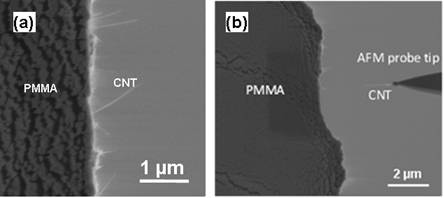www.acsprf.org
Reports: DNI749795-DNI7: Investigating Interfacial Stress Transfer in Carbon Nanotube-Reinforced PMMA Polymers
Changhong Ke, PhD , Binghamton University
The goal of this project is to investigate the interfacial stress transfer between PMMA and embedded individual carbon nanotubes (CNT) in CNT-reinforced PMMA polymers. We successfully manufactured individual free-standing carbon nanotubes partially embedded into thin-film PMMA polymers and performed the pull-out experiments on individual carbon nanotubes inside a high resolution scanning electron microscope. Figure 1(a) shows one of our samples with extruding carbon nanotubes partially embedded into thin-film PMMA polymers. In our study, double-walled CNTs synthesized by chemical vapor deposition (CVD) methods with outer diameter of 2-5 nm and length up to 50 μm, purchased from Sigma-Aldrich, are employed. The CNTs are firstly dispersed in deionized water with the aid of surfactant and ultrasonication. Poly(methyl methacrylate) (PMMA) with molecule weight of ~120,000, purchased from Sigma-Aldrich, is employed. The average extruding length of our manufactured CNTs embedded into thin-film polymer is 0.5~ 2 μm as exemplified by the ones shown in Figure 1(a).
Figure 1: (a) Our dispersed carbon nanotubes partially embedded into thin-film PMMA polymers; (b) one of our CNTs being pulled-out from thin-film PMMA inside a high resolution scanning electron microscope.
We successfully performed in-situ nanomechanical pull-out experiments on individual CNTs inside a high resolution scanning electron microscope. A pre-calibrated atomic force microscope (AFM) probe is mounted to a piezo-driven nanomanipulator stage as a force sensing element. Our nanomanipulator is equipped with close-loop feedback controlled feature and is capable of moving in XYZ axes with a displacement resolution of 1 nm. The AFM tip is first controlled to make contact with, and then welded to the free-end of one desired extruding CNT using electron beam induced deposition of Pt. Then the AFM tip is displaced to pull the CNT out of the polymer. The applied force on the nanotube is calculated from the spring constant of the AFM cantilever and its deflection measured by using the electron beam. Two scenarios are captured by our in-situ nano pull-out experiments: (1) the CNT was broken and was not pulled out from the polymer; (2) the CNT was pulled-out from the polymer without fracture. The first scenario reveals that the total interfacial binding force between the nanotube and the polymer is stronger than the force fracturing the nanotube. This is probably due to a very long embedded length of the nanotube. The second scenario shows that the total interfacial force between the nanotube and the polymer is weaker than the force fracturing the nanotube. By using the peak force measured from the deflection of the AFM cantilever and the geometric parameters of the pulled-out nanotube, the interfacial strength between the nanotube and the polymer can be quantified. Figure 1(b) shows a scanning electron microscopy snapshot of one of our nanotubes being pulled-out by an AFM tip. Our results show that the interfacial strength between the nanotube and PMMA polymers is about 10 MPa. Our results are consistent with the fact that the nanotube is only weakly bonded to PMMA and the data reported in the literature.
In summary, with this PRF support, we successfully characterized the interfacial stress binding strength on the CNT/PMMA interface.
Our research progress from this PRF support also includes the mechanical testing of carbon nanotubes and boron nitride nanotubes. Specifically, we investigated the deformation of carbon nanotube rings under the binding interaction with flat substrates and the radial deformation of individual carbon and boron nitride nanotubes on flat substrates. Our results, which have been reported in three peer-reviewed journal articles, are very useful to understand the interfacial binding interaction in 1D nanostructures and the pursuit of adhesion-involved applications.

